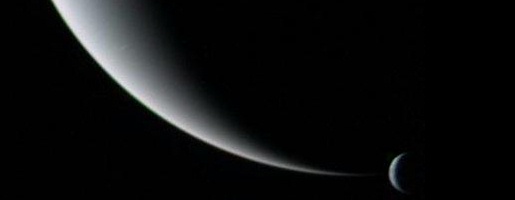 |
|||
|
Parting
shot - Voyager looks back at Neptune and Triton as the spacecraft completes
its grand tour of the outer planets.
|
|||
| THE MOONS OF NEPTUNE | |||
| Neptune's satellites are named after the minor servants of the Roman god Neptune (Greek Poseidon). Before Voyager, the only known satellites of Neptune were Triton, discovered in 1846, and Nereid which was discovered in 1949. Voyager located six more when it visited the Neptune system in 1989. Three more were discovered by astronomers in 2002 bringing the total number of known moons to 11. | |||
| Circular orbits | |||
| The moons, with the exception of Nereid, have very circular orbits. The moons orbit in the plane of Neptune's equator, except for Nereid which has an inclination of 27o and Triton which has an inclination of 160o. Triton is also unusual in that its orbit is retrograde - that is, it orbits in the opposite direction to the rotation of the planet. | |||
| The satellites discovered by Voyager are all fairly close to Neptune. Of the six, Proteus is the outermost, orbiting 118,000 kilometres from the planet. It was their proximity to Neptune and their small size which made them impossible to see from Earth. | |||
 The orbits of Neptune's inner moons. |
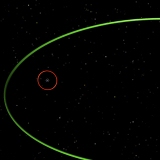 The orbits of Nereid and Triton. |
||
| Distant moons | |||
| The smaller moons are all very dark and reflect less than ten percent of the light that reaches their surface. They have albedo values of about 0.06. Nereid is brighter, with an albedo of 0.2. | |||
| Little more than vague surface markings can be discerned on the small moons. They were imaged from afar. Some of them in Voyager 2 images appear elongated because of rapid motion of the spacecraft. Slightly better pictures were obtained of Proteus and Nereid. One of Neptune's small moons, Galatea, seems to be responsible for altering the structure of one of Neptune's rings. | |||
| The recently discovered moons S/2002 N1, S/2002 N2, and S/2002 N3 are about 30-40 kilometres in diameter, and 'irregular', having either highly elliptical orbits or displaying retrograde motion. Their unusual orbits indicate that they were formed elsewhere in the solar system, and captured later by Neptune's gravitational pull. | |||
| More about Neptune's rings | |||
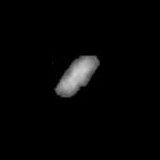 Naiad. |
 Thalassa. |
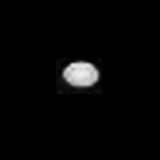 Despina. |
|
| More about Naiad | |||
| More about Thalassa | |||
| More about Despina | |||
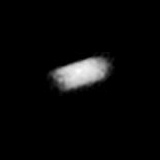 Galatea. |
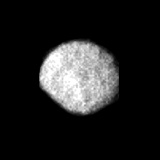 Larissa. |
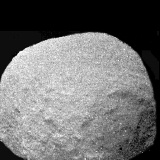 Proteus. |
|
| More about Galatea | |||
| More about Larissa | |||
| More about Proteus | |||
 Nereid. |
|||
| More about Nereid | |||
| Triton | |||
| Triton is Neptune's largest moon with a diameter of 2700 kilometres - it is also Neptune's brightest moon (albedo of 0.7). | |||
| Though coverage of Triton was restricted, the images obtained by Voyager were excellent. They show in great detail Triton's varied and unusual landscapes. They revealed a multi-coloured surface and Triton's polar cap of frozen nitrogen. Ice volcanism was discovered in the form of active geysers which spray dust and gases into the atmosphere, and evidence of molten liquids which had erupted to form new surfaces. | |||
| Triton's retrograde orbit and inclination suggest that it did not originate about Neptune, but was captured. The entry of a new satellite into the system is likely to have caused significant upheaval. Triton may be responsible for launching Nereid into a highly elliptical orbit. | |||
| Triton could have ejected moons from the system altogether, or sent them crashing into Neptune. It may have incorporated orbiting material into its molten mass while other fragments collided and caused disruption amongst the inner satellites. | |||
 Triton. |
|||
| More about Triton | |||
| Neptune's other moons | |||
| Three small moons discovered in 2002 bring the total number of known satellites orbiting Neptune to eleven. They were found by a team of astronomers using the Canada France Hawaii Telescope on Mauna Kea and the Blanco telescope at the Cerro-Tololo Inter-American Observatory in Chile. | |||
| They are the first moons to be discovered about Neptune since the Voyager II spacecraft made a flyby of the planet in 1989. S/2002 N1, N2 and N3 went undiscovered during the Voyager mission because they are so small and so far from the planet. From Earth they would be impossible to detect using normal methods, so astronomers made a series of observations of the sky in the region of Neptune. In the images they built up, which track the planet, stars are recorded as streaks but moons are revealed as points of light. | |||
| Very little is known about newly discovered moons. They orbit far from the planet and their paths are very inclined with respect to the plane of Saturn's equator. The moons S/2002 N2 and S/2002 N3 have prograde orbits, in the same direction as the rotation of Neptune, while S/2002 N1 has a retrograde orbit. The moons orbit Neptune at about 21 million kilometres, four times the distance of Nereid, which at 5 million km from Neptune had been the outermost of the known moons. | |||
| The moons are the smallest members of the Neptunian system found so far. We know roughly how big they are but their physical characteristics- mass, density, and composition are unknown. In the very best telescope images the small moons of Neptune are just small points of light. | |||
| The astronomers who discovered the three moons think they are material ejected from a collision between a passing comet and a larger Neptune orbiting moon. But it is also possible that the irregular satellites are captured asteroids, caught by Neptune's gravitational pull. | |||
| The moons of Neptune are named after personalities from Greek mythology - water nymphs and gods of the sea. The names when chosen for S/2002 N1, N2, and N3 will follow this convention. | |||
|
|
|||